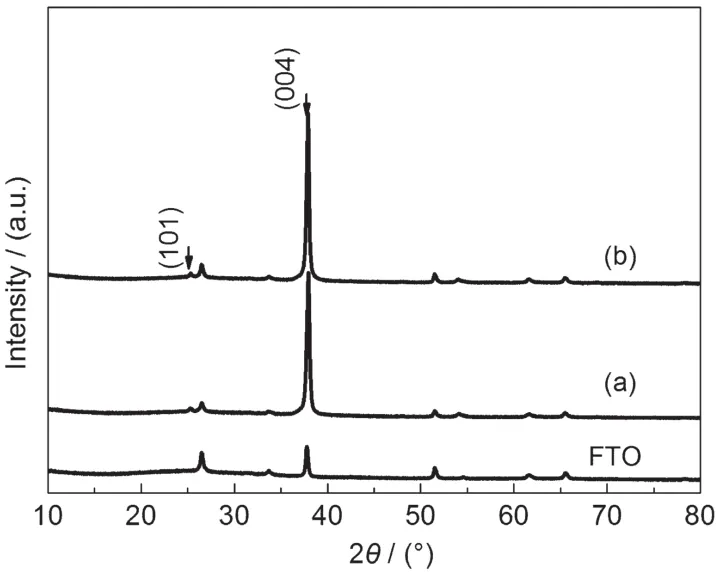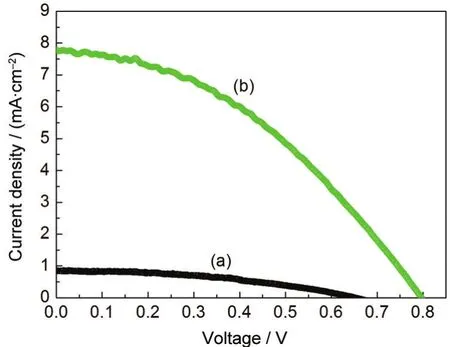TiO2納米片/巢狀分級結構納米陣列薄膜的制備及其在染料敏化太陽能電池中的應用
常萌蕾 李新軍
(1中國科學院可再生能源與天然氣水合物重點實驗室,中國科學院廣州能源研究所,廣州510640; 2中國科學院研究生院,北京100049)
TiO2納米片/巢狀分級結構納米陣列薄膜的制備及其在染料敏化太陽能電池中的應用
常萌蕾1,2李新軍1,*
(1中國科學院可再生能源與天然氣水合物重點實驗室,中國科學院廣州能源研究所,廣州510640;2中國科學院研究生院,北京100049)
采用水熱合成法在氟摻雜二氧化錫(FTO)導電玻璃基底上得到TiO2納米陣列薄膜,并進一步通過NaOH溶液水熱處理制備了由巢狀納米陣列及納米片覆蓋層構成的TiO2納米陣列分級結構一體化薄膜.采用場發(fā)射掃描電鏡(FE-SEM),X射線衍射(XRD),紫外-可見(UV-Vis)漫反射光譜和吸收光譜技術對TiO2薄膜的結構和性質進行表征.FE-SEM結果表明:分級結構TiO2薄膜膜厚為1.5 μm,薄膜由一層納米片覆蓋層(約0.2 μm高)和一層巢狀納米陣列層(約1.3 μm高)組成.XRD譜圖表明TiO2薄膜為銳鈦礦相.UV-Vis光譜顯示分級結構TiO2薄膜具有較強的光捕獲能力和染料吸附能力.TiO2納米片/巢狀分級結構納米陣列薄膜作為光陽極,可有效地提高染料敏化太陽能電池的光電轉換效率,其短路電流(Jsc)為7.79 mA·cm-2,開路電壓(Voc)為0.80 V,填充因子(FF)為0.40,光電轉換效率(η)為2.48%,其光電轉換效率較TiO2納米陣列薄膜提高了近10倍.
TiO2;納米片/巢狀納米陣列;水熱合成;染料敏化太陽能電池;光電轉換
1 Introduction
Dye-sensitized nanocrystalline solar cells(DSSCs)based on TiO2-based nanomaterial have been studied extensively since Gr?tzel and co-workers first reported a low cost and high efficiency DSSC in 1991.1,2A typical DSSC consists of a dye-sensitized photoanode and a Pt counter electrode filled with a liquid redox electrolyte.3,4The morphology and structure of photoanode play important roles in determining the charge transport, dye-loading,and light-harvesting properties,which have significant effects on the final cell performance.5
It is expected that a direct conduction pathway from the point of photogenerated charge carriers to the collecting electrode would improve the conversion efficiency of DSSC.6-8In particular,highly ordered TiO2nanoarrays have been widely used to enhance the electron transportation within the photoanode by providing a direct conduction pathway for the rapid collection of photogenerated electrons.9-13
Another way to increase the efficiency of DSSC is to increase the light-harvesting capability by introducing light scatterers into the photoelectrode.14-16Many previous studies have demonstrated that optical absorption of TiO2nanocrystalline films can be promoted due to the light scattering with the addition of large-sized TiO2particles.17-19
The highly ordered TiO2nanoarrays covered with a lightscattering overlayer could improve the photochemical conversion efficiency due to the enhanced electron transportation and light-harvesting capability.Herein,we reported a novel integrated hierarchicalstructure,nanosheet/nestlikenanoarray TiO2film.By integrating the TiO2films into the DSSC structure,the photoelectric conversion performances were investigated.
2 Experimental
2.1 Materials
All reagents were of analytical grade and used without any further purification.N-719 dye was obtained from Solaronix, Switzerland.Chloroplatinic acid hexahydrate(H2PtCl6·6H2O, 37.5%Pt basis),lithium iodide(LiI),iodide(I2),and 4-tert-butylpyridine were supplied by Westingarea Corporation.Titanium butoxide was purchased from Aladdin Chemistry Co.Ltd. Sulphuric acid(H2SO4,95%-98%),sodium hydroxide(NaOH), and anhydrous acetonitrile were obtained from Guangzhou Chemical Reagent Factory.
2.2 Preparation of TiO2nanostructured array film
The TiO2nanostructured array film was prepared by the hydrothermal synthesis method.Firstly,10 mL of concentrated H2SO4solution was added to 50 mL of water,and then 1 mL of titanium butoxide was added under stirring for 10 min.The solution was transferred to a 100 mL Teflon-lined stainless steel autoclave.Subsequently,the cleaned fluorine-doped tin oxide (FTO)glass was placed at an angle against the wall of the Teflon-liner with the conducting side facing down,and then hydrothermally treated at 150°C for 16 h.Finally,the FTO glass was taken out,washed thoroughly with deionized water,dried in air at room temperature,and heated in air at 500°C for 1 h.
2.3 Preparation of a nanosheet/nestlike nanoarray hierarchical TiO2film
The above prepared TiO2nanostructured array film on FTO substrate was placed in an autoclave.The NaOH solution(60 mL,10 mol·L-1)was added to the above autoclave.The hydrothermal reaction was kept at 150°C for 4 h.The resultant TiO2film was thoroughly rinsed with deionized water and then treated with 0.1 mol·L-1HNO3solution for 30 min.It was again thoroughly rinsed with deionized water and then dried at room temperature for subsequent characterization and measurement.
2.4 Characterization
The morphology of the films was inspected using a fieldemission scanning electron microscope(FE-SEM,Hitachi S-4800).The crystalline structure of the films was examined by powder X-ray diffraction(XRD,Philip X?pert Pro MPD) with Cu Kαradiation from 10°to 80°.The diffuse reflectance spectra of TiO2films and the absorption spectra of dye-loaded TiO2films were recorded by an ultraviolet-visible(UV-Vis) spectrophotometer(U-3010,HITACHI)equipped with an integrating sphere in the range of 350-700 nm.The width of slit was 2.0 nm and the step was 0.5 nm.Photocurrent-voltage curves of DSSCs were measured by a CHI660A electrochemical workstation under the illumination of simulated sunlight with a 300 W xenon lamp(Changtuo,Beijing,AM 1.5,100 mW·cm-2).
The TiO2array film electrodes with the active area of 0.6 cm×0.6 cm were soaked in an ethanol solution of N-719 dye for about 24 h.Then the dye-adsorbed TiO2array film electrodes were assembled into sandwich type cells with a counter electrode(platinum-deposited fluorine-doped tin oxide glass slice)by clamps.A drop of electrolyte composed of 0.1 mol· L-1LiI,0.05 mol·L-1I2,and 0.5 mol·L-14-tert-butylpyridine in acetonitrile was introduced into the clamped electrodes by capillarity.
3 Results and discussion
Fig.1 shows FE-SEM images of the TiO2nanostructured array film and the nanosheet/nestlike nanoarray hierarchical TiO2film.Fig.1(a)shows a cross-sectional SEM image of the TiO2nanostructured array film obtained by the hydrothermal synthesis,which shows that the densely packing TiO2nanostructured arrays with~1.5 μm height are perpendicularly grown on the FTO substrate.After further hydrothermal treatment with NaOH solution,the nanosheet/nestlike nanoarray hierarchical TiO2film was obtained,as shown in Fig.1(b-d).It can be seen from Fig.1(b,c)that a nestlike TiO2nanoarray layer is integrated with nanosheet network overlayer,and the nanosheet overlayer covers on the nestlike nanoarrays?surface.The nestlike nanoarray layer(~1.3 μm height)grown on FTO substrate is assembled by many arranged nanoparticles and tiny nanosheets, and the top layer(~0.2 μm height)with nanosheet networks stands on the surface of the nestlike nanoarray layer.The nanosheets alternately connect with each other to form nanosheet networks(see Fig.1(d)).The TiO2nanosheets are about 10 nm in thickness and hundreds of nanometers in planar size.It could be proposed that the transformation of TiO2nanostructured array film to spontaneously self-assemble the nanosheet/nestlike nanoarray TiO2hierarchical structure is due to a dissolution-recrystallization process via NaOH solution under the hydrothermal driving force.
Fig.2 shows the XRD patterns of the TiO2nanostructured array film(curve a)and the nanosheet/nestlike nanoarray hierarchical TiO2film(curve b).XRD patterns indicate that the diffraction peak of both TiO2films appears at 25.3°which corresponds to TiO2(101)diffraction of the anatase phase(JCPDS No.21-1272).In contrast to FTO,the enhanced diffraction peak of both TiO2films at 37.9°is from the(004)anatase TiO2peak completely overlapped with(200)FTO peak.The intensity of diffraction peaks of the nanosheet/nestlike nanoarray hierarchical TiO2film is similar to that of TiO2nanostructured array film.

Fig.1 FE-SEM images of TiO2nanostructured array film(cross-sectional view(a))and the nanosheet/nestlike nanoarray hierarchical TiO2 film(cross-sectional view(b and c)and top view(d))

Fig.2 XRD patterns for the TiO2nanostructured array film(a) and the nanosheet/nestlike nanoarray hierarchical TiO2film(b)
An enhancement of light-scattering ability of the TiO2film is an effective way for DSSCs to improve the light-harvesting efficiency of the TiO2photoanode.20The difference in light-scattering abilities of the different films could be reflected by the diffuse reflectance spectra.As can be seen from Fig.3(a),compared with the TiO2nanostructured array film,the nanosheet/ nestlike nanoarray hierarchical TiO2film has higher light-scattering ability in the visible regions.The enhancement in light-scattering ability of the hierarchical TiO2film is likely due to the inimitable nanosheets with hundreds of nanometers in size(see Fig.1(d)).The dye-loaded TiO2nanostructured array film and nanosheet/nestlike nanoarray hierarchical TiO2film were investigated by means of UV-Vis absorption spectra (Fig.3(b)).The absorption wavelengths of the both TiO2films present an absorption peak centered around 520 nm,corresponding to the metal-to-ligand charge-transfer(MLCT)absorption peaks.21The MLCT absorption originates from the dye molecules adsorbed on the TiO2surface and is related to the film structure.Owing to the improvement of the light-harvesting efficiency and the increase of dye loading,the MLCT absorption intensity of nanosheet/nestlike nanoarray hierarchical TiO2film is significantly higher than that of TiO2nanostructured array film.

Fig.3 Reflectance spectra of TiO2film samples(a)and UV-Vis absorption spectra of TiO2film samples with adsorbed N-719 dye(b)

Fig.4 Photocurrent density voltage curves of DSSCs based on TiO2nanostructured array film(a)and nanosheet/nestlike nanoarray hierarchical TiO2film(b)

Table 1 Characteristics of DSSCs based on TiO2nanostructured array film and nanosheet/nestlike nanoarray hierarchical TiO2film
The TiO2films were also employed as photoanodes in dyesensitized solar cells.Fig.4 shows typical current density versus voltage curves of the both TiO2films and the resultant photovoltaic parameters are summarized in Table 1.Compared with TiO2nanostructured array film,the nanosheet/nestlike nanoarray hierarchical TiO2film exhibits the higher open-circuit voltages(Voc)of 0.80 V and a drastic increase of photocurrent density(Jsc)from 0.84 to 7.79 mA·cm-2.The photoelectric conversion efficiencies(η)of the DSSCs for the nanosheet/ nestlike nanoarray hierarchical TiO2film and the nanostructured array film are 2.48%and 0.23%,respectively.As a result, the nanosheet/nestlike nanoarray hierarchical TiO2film exhibits nearly 10 times higher conversion efficiency as compared to the nanostructured array film.The improved conversion efficiency can be attributed to the nanosheet/nestlike nanoarray hierarchical structure which leads to the increase of dye loading and the higher light-harvesting capability.
In the DSSC,the enhancement of JSC,Voc,and photoelectric conversion efficiency for the nanosheet/nestlike nanoarray hierarchical TiO2film may be attributed to the textural and structural properties.The JSCis dependent on the light-harvesting efficiency,dye loading amount,and charge transport properties.22The hierarchical TiO2film is comprised of nanosheet networks and TiO2nestlike nanoarrays.The nanosheets are submicrometer-sized and,thus,can function as efficient light scatterers to enhance the light harvesting efficiency.And the networks provide the film with the necessary porous structure and large internal surface area for increasing the number of chemisorbed dye molecules.The increase of light scattering ability would enhance the light-harvesting capability of the hierarchical TiO2film and the increase of dye loading amount leads to more electron-hole pairs generated.On the other hand,the nestlike nanoarrays can provide the direct conduction pathways for efficient transport of photogenerated electrons and hold back the photogenerated carrier recombination.And thus the open circuit voltage and the short-circuit current density increase.Owing to the higher Jscand Voc,the photoelectric conversion efficiency of the nanosheet/nestlike nanoarray hierarchical TiO2film is improved.
4 Conclusions
A novel integrated hierarchical structure,nanosheet/nestlike nanoarray TiO2film,has been obtained by NaOH solution posthydrothermal treatment on hydrothermally synthesized TiO2-derived nanostructured arrays.The nanosheet/nestlike nanoarray hierarchical TiO2film shows significant improvement in light-harvesting and dye adsorption.Despite the very low film thickness of about 1.5 μm,when integrating the nanosheet/nestlike nanoarray hierarchical TiO2film into the DSSC structure, the photoelectric conversion efficiency of 2.48%is achieved, which is nearly 10 times higher than that of the nanostructured array film.
(1) Oregan,B.;Gr?tzel,M.Nature 1991,353,737.
(2) Yu,J.G.;Fan,J.J.;Cheng,B.J.Power Sources 2011,196, 7891.
(3) Santa-Nokki,H.;Kallioinen,J.;Kololuoma,T.;Tuboltsev,V.; Korppi-Tommola,J.J.Photoch.Photobiol.A 2006,182,187.
(4)Wang,W.L.;Lin,H.;Zhang,L.Z.;Li,X.;Cui,B.;Li,J.B. Acta Phys.-Chim.Sin.2010,26,1249.[汪文立,林 紅,張羅正,李 鑫,崔 柏,李建保.物理化學學報,2010,26,1249.]
(5)Wang,H.E.;Zheng,L.X.;Liu,C.P.;Liu,Y.K.;Luan,C.Y.; Cheng,H.;Li,Y.Y.;Martinu,L.;Zapien,J.A.;Bello,I.J.Phys. Chem.C 2011,115,10419.
(6) Du Pasquier,A.;Chen,H.H.;Lu,Y.C.Appl.Phys.Lett.2006, 89.
(7)Dong,X.;Tao,J.;Li,Y.Y.;Wang,T.;Zhu,H.Acta Phys.-Chim. Sin.2009,25,1874.[董 祥,陶 杰,李瑩瀅,汪 濤,朱 宏.物理化學學報,2009,25,1874.]
(8) Zhao,L.;Yu,J.G.;Fan,J.J.;Zhai,P.C.;Wang,S.M. Electrochem.Commun.2009,11,2052.
(9) Mor,G.K.;Shankar,K.;Paulose,M.;Varghese,O.K.;Grimes, C.A.Nano Letters 2006,6,215.
(10) Sauvage,F.;Di Fonzo,F.;Bassi,A.L.;Casari,C.S.;Russo,V.; Divitini,G.;Ducati,C.;Bottani,C.E.;Comte,P.;Gr?tzel,M. Nano Letters 2010,10,2562.
(11) Zeng,Q.H.;Wu,L.Z.;Zhang,Y.;Qi,B.;Zhi,J.F.Scripta Mater.2010,62,810.
(12) Li,H.H.;Chen,R.F.;Ma,Z.;Zhang,S.L.;An,Z.F.;Huang, W.Acta Phys.-Chim.Sin.2011,27,1017.[李歡歡,陳潤鋒,馬 琮,張勝蘭,安眾福,黃 維.物理化學學報,2011,27, 1017.]
(13) Zhang,Q.F.;Chou,T.R.;Russo,B.;Jenekhe,S.A.;Cao,G.Z., Angew.Chem.Int.Edit.2008,47,2402.
(14) Yu,H.;Tian,B.Z.;Zhang,J.L.Chem.Eur.J.2011,17,5499.
(15) Koo,H.J.;Kim,Y.J.;Lee,Y.H.;Lee,W.I.;Kim,K.;Park,N. G.Advanced Materials 2008,20,195.
(16)Liu,R.H.;Zhang,S.;Xia,X.Y.;Yun,D.Q.;Bian,Z.Q.;Zhao, Y.L.Acta Phys.-Chim.Sin.2011,27,1701. [劉潤花,張 森,夏新元,云大欽,卞祖強,趙永亮.物理化學學報,2011,27, 1701.]
(17) Kang,S.H.;Kim,J.Y.;Kim,H.S.;Koh,H.D.;Lee,J.S.; Sung,Y.E.J.Photochem.Photobiol.A 2008,200,294.
(18) Durr,M.;Bamedi,A.;Yasuda,A.;Nelles,G.Appl.Phys.Lett. 2004,84,3397.
(19)Wang,Z.S.;Kawauchi,H.;Kashima,T.;Arakawa,H.Coordin. Chem.Rev.2004,248,1381.
(20) Qiu,Y.C.;Chen,W.;Yang,S.H.Angew.Chem.Int.Edit.2010, 49,3675.
(21)Nazeeruddin,M.K.;Kay,A.;Rodicio,I.;Humphrybaker,R.; Muller,E.;Liska,P.;Vlachopoulos,N.;Gr?tzel,M.J.Am. Chem.Soc.1993,115,6382.
(22) Rao,F.;Song,Z.T.;Gong,Y.F.;Wu,L.C.;Feng,S.L.;Chen, B.Nanotechnology 2008,19,445706.
February 17,2012;Revised:March 14,2012;Published on Web:March 16,2012.
Fabrication of Nanosheet/Nestlike Nanoarray Hierarchical TiO2Film for Dye-Sensitized Solar Cell
CHANG Meng-Lei1,2LI Xin-Jun1,*
(1Key Laboratory of Renewable Energy and Gas Hydrate,Guangzhou Institute of Energy Conversion,Chinese Academy of Sciences, Guangzhou 510640,P.R.China;2Graduate University of Chinese Academy of Sciences,Beijing 100049,P.R.China)
A hierarchical configuration of TiO2nanoarray film,comprising a nestlike TiO2nanoarray layer integrated with a nanosheet network overlayer,was constructed.The hierarchical TiO2film was obtained by the post-hydrothermal treatment with NaOH solution on hydrothermally synthesized TiO2-derived nanostructured arrays grown on fluorine-doped tin oxide substrate(FTO).The TiO2films were characterized by field-emission scanning electron microscope(FE-SEM),X-ray diffraction(XRD),ultraviolet-visible(UV-Vis) diffuse reflectance spectroscopy,and absorbance spectroscopy.FE-SEM shows that the hierarchical TiO2film with a thickness of 1.5 μm is composed of a nanosheet overlayer(~0.2 μm height)and the nestlike nanoarray layer(~1.3 μm height).XRD patterns display that the TiO2films have pure anatase phase structure.UV-Vis spectra reveal enhanced light scattering and dye adsorption ability of the hierarchical TiO2film.For the dye-sensitized solar cell(DSSC)based on the nanosheet/nestlike nanoarray hierarchical TiO2film,a short-circuit current(Jsc)of 7.79 mA·cm-2,open-circuit voltage(Voc)of 0.80 V,fill factor(FF)of 0.40,and photoelectric conversion efficiency(η)of 2.48%are achieved.Within the dye-sensitized solar cell,the photoelectric conversion efficiency of the hierarchical TiO2film was nearly ten times higher than that of nanostructured array film.
TiO2;Nanosheet/nestlike nanoarray;Hydrothermal synthesis;Dye-sensitized solar cell; Photoelectric conversion
10.3866/PKU.WHXB201203161
?Corresponding author.Email:lixj@ms.giec.ac.cn;Tel:+86-20-87057781.
The project was supported by the National Natural Science Foundation of China(51172233)and National Key Basic Research Program of China (973)(2009CB220002).
國家自然科學基金(51172233)與國家重點基礎研究發(fā)展計劃項目(973)(2009CB220002)資助
O649

